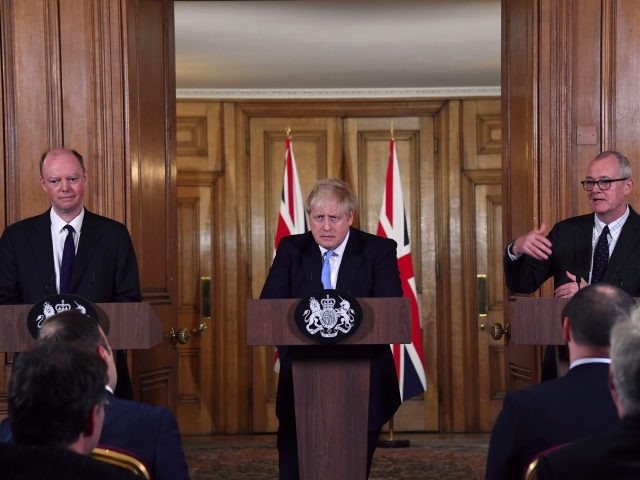Ministers have reportedly admitted that the government has “bowed to” the advisory body SAGE, which they admit has no counterbalance, and that the body’s role would be reviewed after the pandemic.
The last Labour government had formed the Scientific Advisory Group on Emergencies (SAGE), which had met only a handful of times between 2009 and 2019 before taking a pivotal role in directing government health policy related to the Chinese coronavirus pandemic, meeting 74 times last year.
Ministerial sources speaking to The Telegraph on Monday admitted that it had “bowed to” SAGE too often and that the government lacked an adversarial “red team” to check its scientific advice and recommendations.
Sources speaking to the newspaper said that the review would investigate whether SAGE had too much power and whether it prevented alternative views was being given equal consideration by the government. Ministers are likely to demand power to appoint members of SAGE.
Last month, it was claimed that Chancellor of the Exchequer Rishi Sunak was “concerned” that the government’s health technocrats were “moving the goalposts” in a bid to keep the country under shutdown.
A source close to the senior minister told the media that “Rishi is concerned that the scientists have been moving the goalposts in recent weeks. It’s no longer just about hospitalisations and protecting the NHS but cases and case numbers.”
They continued: “Now the target seems to be that we need to keep cases down overall, which wasn’t the original aim of the lockdown. Six months ago, the goal was protecting the most vulnerable who end up hospitalised with Covid. Over the last few weeks, the goalposts seem to have shifted with the new variants. The talk has switched to becoming Covid-free.”
UK Chancellor ‘Concerned’ by Health Technocrats ‘Moving the Goalposts’ to Keep Lockdown https://t.co/Wv4t1hs9PS
— Breitbart London (@BreitbartLondon) February 4, 2021
Some of SAGE’s controversial recommendations include telling families not to hug or sing carols at Christmas, advising mask-wearing in busy settings outside, and suggesting GPS tracking of those subject to quarantine orders.
SAGE’s subgroup, the Scientific Pandemic Influenza Group on Modelling (SPI-M), had predicted social distancing measures could be in place until the end of 2021.
While the New and Emerging Respiratory Virus Threats Advisory Group (NERVTAG), which has several of its members also belonging to SAGE and SAGE subgroups, had predicted in December that “immunity certification” — or vaccine passports — is “likely to be possible”.
Its most senior figures Sir Patrick Vallance, the government’s Chief Scientific Adviser, and Professor Chris Whitty, the Chief Medical Officer, often attend the government’s emergency Cabinet Office Briefing Room (Cobra), with both men deciding which other scientific or medical advisers attend the sensitive meetings.
Campaigners demanding transparency last year succeeded in forcing the government to release a partial list of SAGE’s membership, with the government, until May 2020, keeping the list secret on grounds of national security.
One of the names disclosed was the Imperial College epidemiologist Neil Ferguson, later known as “Professor Lockdown”, whose recommendations was instrumental in the government’s first coronavirus lockdown in March 2020.
Days after the names were published, Ferguson was forced to resign from his government advisory position after it was revealed the married epidemiologist had broke lockdown twice to allow his mistress, who was said to be in an “open marriage”, to visit him.
Months later, Ferguson was confirmed to have returned to advising the prime minister, listed on the government website as of March 16th as a member of SAGE and the subgroup SPI-M.
Return of Professor Lockdown: Disgraced Neil Ferguson Advising Boris Johnson on Coronavirus ‘Mutation’ https://t.co/a66lcIv1dS
— Breitbart London (@BreitbartLondon) December 22, 2020

COMMENTS
Please let us know if you're having issues with commenting.